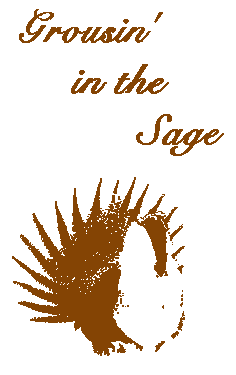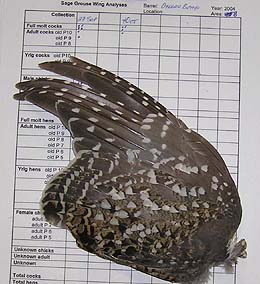






powered by SignMyGuestbook.com

| Newest
Older Previous Next Random Contact Profile Host |
blizzard warnings - 13:52 , 03 October 2013 heelerless - 21:32 , 18 August 2013 Red Coat Inn in Fort McLeod - 11:38 , 23 June 2013 rushing into the waters - 09:53 , 21 June 2013 choosing a spot - 17:43 , 27 April 2013 |
wing bee 2004
Normally we wouldn't start the wing bee until nine o'clock. A late start in the morning that allowed most in the group to hit the nearby management area in pursuit of pheasants and or ducks, and me perhaps a trip to the stone wheel. But pheasant season shooting hours don't even start until 11 o'clock this year, so some of us were reading wings by 07:30, and all were there by eight o'clock.
With hopes of being done before 11 o'clock.
We weren't.
Had a couple newbies along. One who hadn't read any sort of wing since college, and another who could read quail quite well, but knew nothing about reading sage grouse wings. So, without warning, I was put in the position of providing a hands-on tutorial.
Which would have been fine, except every year I have to relearn how to do this. I mean, knowing that pointed flight feathers are juvenile feathers, and the rounded ones are adult is easy to remember. Likewise remembering the broad, wide stripe along the central rachis (main vein) of the wing coverts (short feathers that cover the bases of the long flight feathers) on chick wings. And the sharply pointed secondary feather on the inside of the wrist of chick wings.
But many of these obvious characteristics have been molted by the end of September or early October, and so you have to go to the more subtle differences. The slight fading of the outer flight feathers that tell you you've got a yearling bird. That female wings less than 222mm when measuring from the wrist joint to the tip of primary flight feather number 4 are chicks, and the ones greater than 222m are hens.
That sort of thing.
It looked like my wing collections were down, which I attribute to a lack of hunters in the late season, rather than a lack of birds. But other folks brought lots of wings.

A few interesting little notes.
Normal pattern is for a sage grouse chick (or any grouse, for that matter) to molt away its pointed juvenile feathers numbered 1 through 8 (from inside wrist to outer edge of wing) and retain the outer two flight feathers, numbers 9 and 10, for another year. Hence the yearling wings with two faded, pointed outer flight feathers.
But every once in a while, you'll get a chick that apparently molts numbers 1 through 9 instead, leaving you with an odd yearling with only one faded, pointed outer flight feather. Nobody else in our state had noticed these before, but I found about 1 1/2 percent of my hens were these odd molters. And warned my new neighbor biologist about these before we started.
First wing she picked up was one of these odd yearling hens. By the end of the morning we had found at least a half dozen. Something strange went on with their molts last fall.
Other oddity was this wing.

Those of you astute at reading wings will notice that this is not a sage grouse wing. The white spots tell you immediately it is from a sharptailed grouse, not a sage grouse.
That's not the odd part.
The odd part is where that wing was deposited. In a wing barrel near the Oregon Buttes. Probably 70-80 miles from any known sharptail population. Now, maybe somebody hunted sharptails in an ordinary place, then later went after sage grouse in the west end of the desert and just dropped off their sharptail wing along with their sage grouse wings.
Or maybe somebody is just messin' with us. (Been done before... I've had pheasant, chukar, and seagull wings show up in my barrels.)
But since one subspecies of sharptail is under consideration for listing under the Endangered Species Act, it's kind of important that we know where we got 'em, and which kind. So that wing is off to the lab for DNA analysis, and hopefully, subspecies identification.
We didn't get done with wings until after noon. Our work area tends to get a little messy, with dust, feathers and dead maggots accumulating on the tables and garage floor.

So we weren't done cleaning up and on the road until after one o'clock.
And, as usual, the title of grossest wing collections was bestowed upon the one who brought the stinkiest, rottenest, most maggot filled bags of wings. The one who had most neglected getting the specimens frozen soon after collection. These bags literally had clumps of maggots fall out with the wings, a few of which had been consumed down to just feathers and bones, reeking of the urine of maggot decay.
Yeah. They were mine.